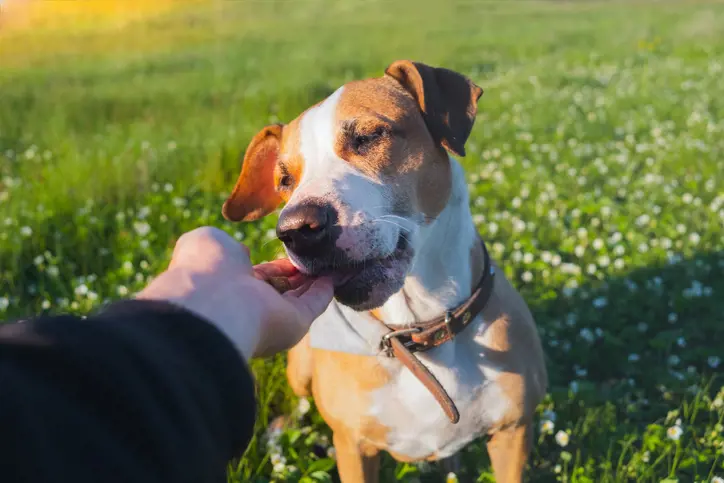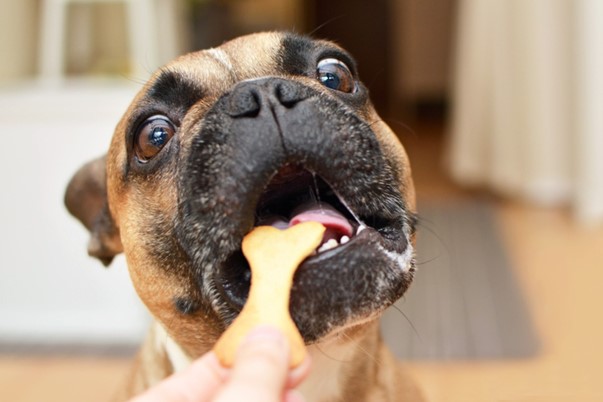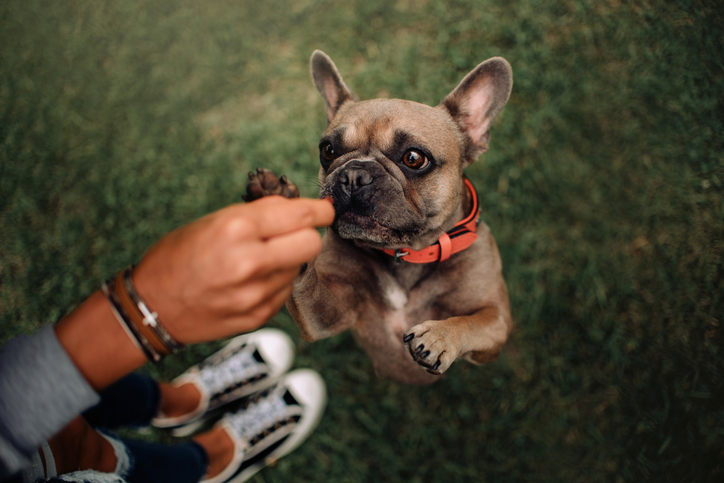Healthy treats for dogs
13th September, 2021

We all like to treat our four-legged friends from time to time – perhaps as a way of rewarding good behaviour, during a training session or just as an expression of our love for them. But with over half of all dogs in the UK said to be overweight, as per data from Burgess Pet Care, giving our pups the right kinds of treats is more important than ever.
The research indicates that Pugs are the dog breed most likely to be overweight, with three quarters branded as obese by vets. Similarly, more than two-thirds of Boxers were found to be carrying a few extra pounds, along with German Shepherds, Golden Retrievers, Spaniels and Staffordshire Bull Terriers. Excess weight can lead to severe health problems down the line, and could see you claiming on your dog insurance for veterinary care.
Dog owners aren’t overfeeding their pets willingly. Burgess Pet Care’s survey shows that more than three quarters of pet owners are simply unsure how much their pets should weigh, while a third admits to not keeping the portion size under control.

‘Killing them with kindness’
However, many pet owners are in denial about their dog’s weight – more than two-thirds think their dog is exactly the right weight and admit to not being worried about pet obesity, as per Pet Food Manufacturers Association research.
Just 41% of owners think excessive treating contributes most to obesity – compared to 98% of vets.
The British Veterinary Association pulls no punches in its advice on its website: “Pets are an important part of the family and while many owners show love for their pet through food, this is often a case of killing them with kindness. Prevention is better than cure, which is why we would encourage owners to seek advice from their vet on proper nutrition, exercise and how to recognise healthy body condition.”
Recognising healthy body condition
Before we get into what represents a healthy treat for dogs, it’s important to be able to identify if your pet is overweight. The RSPCA outlines some visual checks you can carry out:
- Give your dog a quick cuddle and see if you can see and feel the outline of their ribs and without excess fat covering.
- The same goes for your dog’s waist; it should be clearly visible when viewed from above.
- When looking at your dog side-on, their belly should be tucked up and without anything sagging down.
If you see the signs of obesity, you shouldn’t ignore them. Being overweight can lead to health problems or make any existing conditions even worse. By over-feeding your canine you could be putting them at risk from developing things like diabetes, heart disease, respiratory distress, high blood pressure and cancer.
When issues like this start to take hold, they can prove expensive to treat. Comprehensive dog insurance can help cover the vet bills at what can be a very stressful time. But, it would be better to take preventative action to stop obesity becoming an issue for your dog in the first place.
Cutting down on dog treats
As a place to start, you should rein in how many treats you give your dog. It might feel cruel to deny your pooch the treats they have become accustomed to, but it’s the opposite: you’re potentially putting a couple of years on their life by applying a bit of control.
But just how much calorie curbing is required? Well, vets suggest that treats should never make up more than 10% of your pet’s daily calorie intake. If your dog is overweight, it might be worth taking treats out of their diet completely for a period of time. If you continue to offer treats, reduce the size of your pet’s main meal.
Remember, treats come in all shapes and sizes. When you’re considering whether or not to give your dog some of the offcuts from your plate, consider the following from animal welfare charity Blue Cross: “A slice of buttered toast to a Cocker Spaniel provides about a sixth of their daily calorie requirement. A sausage to a Staffie is the equivalent of one and a half chocolate bars to a person and a chocolate digestive to a Jack Russell is almost the same as a portion of chips to a person.”
If these are considered as ‘treats’, they clearly make up more than 10% of your pet’s daily calorie intake. So, you might want to think again before offering your dog a sneaky sausage from your plate. As much as anything else, sharing food can cause behaviour problems, such as begging, when you’re trying to eat. You also need to be wary that many human foods can be ‘toxic’ or harmful to dogs – so what can seem like some innocent sharing can prove extremely dangerous for your dog if you’re not careful.
Our advice? Stick to the healthy dog treats, and only give them when you’re trying to get your pooch to exhibit good behaviour.
Healthy treats are fine – just don’t over do them
High-quality, healthy dog treats can bring some added nutrients to your pet’s diet, and can even help reduce the risk of them eating something dangerous by satisfying their hunger in between meals.
Some dog treats promise benefits including a healthier coat, joints and mouth – but it’s always worth looking into these claims a little closer before handing them over to your dog. You can’t go far wrong with dental chew treats, while it’s true that things like yak milk blocks can help to keep your dog’s teeth clean, while freshening their breath at the same time.
If your dog is on a diet, keep the treats light, and if your dog is an allergy sufferer, keep a look out for hypoallergenic rewards.
As we’ve already mentioned – in addition to the health benefits of some healthy dietary supplements – treats are a great way of rewarding your bet for behaving in a way that pleases you.
So, use them wisely – your pet doesn’t need a treat every time they show you some affection or act in a way that brings a smile to your face. Remember, grooming, walking and play time are just as rewarding for your pet as being offered a treat!
How should you give your dog a treat?
In those moments where you want to treat your dog for good behaviour or having learned a new skill, there’s a knack to handing over the goods, as Pets at Home explains. Here's their advice on how to give your dog a treat for maximum impact:
- Pick your treat – your dog’s ultra-sensitive nose will mean they know exactly what is about to happen!
- This might prompt your pet to get a little over-excited. As endearing as it is, this is not a desirable behaviour, so show your dog you disapprove.
- Don’t hand over the treat until they’ve calmed down.
- Grip the treat between your fingers and thumb or on your palm.
- Hold the treat in a closed fist to prevent nipping or biting and only hand it over when your dog is calm and gentle.

What healthy treats should you give a dog?
There are a huge number of brands now selling all manner of dog treats that you can buy at the supermarket, pet shop and vets. However, not all of them will prove to be that healthy for your dog.
It can be tricky to gauge what is healthy and what isn’t just from looking at the ingredients (although as a rule of thumb, you should be wary of anything you’ve not heard of or can’t pronounce). So, your best bet is to speak to your vet. Purely Pets policyholders also have access to a 24-Hour Vet Helpline where you can get instant advice from a veterinary professional.
However, all dog treats don’t have to come from a specialist shop. Chances are, you’ll already have something lying around in your kitchen or fridge that they’ll be only too willing to gobble up!
Here’s what dog food specialist Purina suggests when it comes to healthy treats:
-
Regular dog food
You don’t need to buy anything special when it comes to dog treats – just use a handful of your dog’s everyday dry food. But make sure it falls within their daily allowance and not on top of it, especially if you’re trying to keep their weight down.
-
Boiled chicken
Keeping it plain and simple – no oil or seasoning – you can’t go far wrong with some lean, boiled chicken breast, cut up into small pieces. Chicken is gentle on your dog’s stomach, and it’s also filled with omega-6 fatty acids which help to promote healthy skin and coat.
Salmon can also work as a healthy doggy treat but canines who have suffered with pancreatitis in the past should avoid it.
-
Peanut butter
A word of warning first: you need to be very careful not to feed a dog peanut butter that contains salt, sugar or artificial sweeteners. Xylitol, in particular, can be deadly so look out for that in the ingredients (it might be listed as birch sugar or E967).
A spoonful of unsweetened peanut butter, however, without any of the additives, will do your dog no harm and makes for a delicious treat for them. Peanut butter is also a good source of protein and it’s full of vitamins and nutrients.
-
Pumpkin
Ok, so you might not have a pumpkin knocking about the kitchen unless it’s Halloween, but when you do have some in the house, make sure that you let your dog loose on it. Pumpkin pulp is low in calories and will give your canine a nice shiny coat. It might only prove to be a seasonal treat, but waste not want not!
-
Apple slices
You’re much more likely to have some apple sitting in the fruit bowl than you are a pumpkin. Apples can help to clean teeth and freshen breath in an instant. Nobody wants smelly dog breath in their face, no matter how much you might love them.
Just be sure to slice apples into nice small pieces to avoid them becoming a choking hazard for your dog. If you’re unsure what to do if your dog starts to choke on its food, read our handy guide here.
Also check that any apples are unseeded and never give your dog the core as the seeds contain traces of cyanide which can be harmful if regularly consumed.
-
Fresh vegetables
Broccoli might not be your first thought when it comes to delicious doggy treats, but you’d be wrong! Our pups can find fresh veg just as tasty as we do. If you’re trying to control their weight, carrots and green beans are also healthy options. Just cut them up into tiny chunks to avoid that choking hazard. You might want to consider grating the vegetables for this reason.
Just be wary not to overdo the veg as they can cause tummy issues such as loose stools and flatulence… enough said.
Get dog insurance from Purely Pets
No matter how healthy you try to make your dog’s lifestyle, injury or illness can strike at any point. You can’t wrap a dog up in cotton wool, no matter how much you might want to. Your best bet is to prepare yourself for the unexpected so that your dog can get the treatment that they need quickly, without putting any extra financial strain on you.
Dog insurance from Purely Pets can safeguard you against the costs of unexpected vet bills, or treatments that your beloved pet may require if they develop a condition in their lifetime.
Other benefits from taking out a policy with us include a 24-Hour Vet Helpline that you can call to get answers to your dog-related queries.
Our online policy management portal means you can manage your dog insurance policy at a time that suits you.
With excess starting from as little as £60 and 15 levels of lifetime cover to choose from, there’s bound to be one that’s right for you and your pet.
Contact us for a dog insurance quote today.
Policy benefits, features and discounts offered may very between insurance schemes or cover selected and are subject to underwriting criteria. Information contained within this article is accurate at the time of publishing but may be subject to change.
Helpful Pages
Recent Posts
Pet Insurance Quote
- 98% claims paid *
- Claims paid directly to vets
- 24/7 vet video consultations
- Interest free monthly payments




